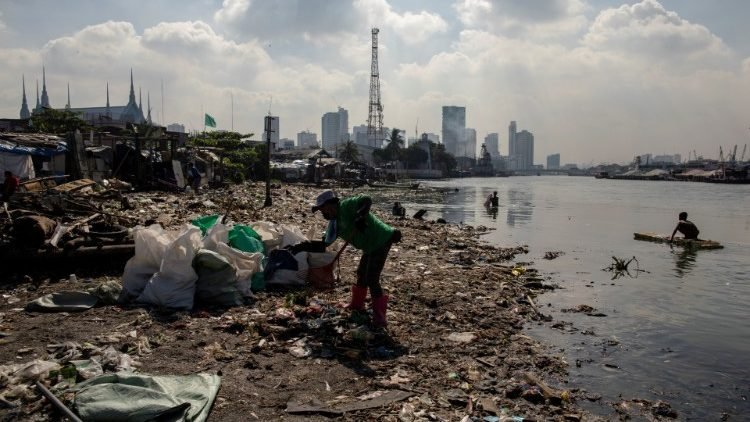The detection of microplastics in the ambient air of Metro Manila, Philippines, should be considered a “wake-up call” for Filipinos as plastic pollution persists in the country, say two Filipino environmental scientists.
By Zeus Legaspi
Two environmental scientists from Mindanao State University-Iligan Institute of Technology have said that Filipinos in Metro Manila should be warned about the possibility of inhaling microplastics amidst the country’s persistent plastic pollution problem.
“Microplastics are actually small fragments of plastics coming from a bigger form. Their size is less than five millimeters,” said Rodolfo Romarate, one of the scientists, in an interview with Vatican News.
“The air is actually a highway for microplastics,” he emphasized.
Romarate explained that as bigger plastics disintegrate due to their exposure to a harsh environment such as urban Metro Manila, they disintegrate into smaller pieces, thus becoming microplastics. The wind then carries these and may become suspended in the air, causing atmospheric microplastics.
In their recent study, the scientists found that in 16 cities and one municipality in Metro Manila, all have had some amount of particulate matter, with the highest concentration found in Muntinlupa City and Mandaluyong City.
“If you live in Mandaluyong, there is a likelihood that you will inhale 88 microplastics in a year,” said scientist Dr. Hernando Bacosa. He clarified, however, that the number is simply a projection and may change depending on the consistent number of microplastics in the air and the person’s constant exposure to them.
When asked who could be the most susceptible to microplastic inhalation, Dr. Bacosa said, “The people who are outside: the commuters, traffic enforcers, people walking on the sidewalks… basically everyone.”
While the figures may not appear to be alarmingly significant at first glance, the scientist said that plastic pollution, now that microplastics are found in the air, should be treated as a crisis.
“Now, we have detected it at certain levels. We don’t have to wait until we detect more than 1,000 in the air,” he said.
Health Effects
The scientists cautioned that inhaling microplastics may have hazardous effects on one’s health.
“A recent study showed that once micro and nano plastics enter the body, it can cause oxidative stress in our organs,” Dr. Bacosa said.
“So, when our organs – our cells – are suffering from oxidative stress, that hampers their normal functioning. In the long run, if that persists, this could lead to more severe health effects,” he continued.
The scientists also said that they are looking into the possibility of microplastics as carriers of bacteria, viruses, and heavy metals.
“When the microplastic particle is floating in the air, for example, it’s being carried from one city to another, it also captures with it suspended bacteria in the air,” Dr. Bacosa said.
The environmental scientist, however, clarified that since they are still emerging pollutants, micro, and nano plastics are not yet well studied, and the extent of their health effects is yet to be fully understood.

Types of atmospheric microplastics found in Metro Manila air categorized based on shape. From upper left to lower right: granules, fiber, fragment, and film. Photo from Romarate et. al.
‘Plastic is everywhere’
He also said that the presence of suspended atmospheric microplastics in the ambient air of Metro Manila should be seen as a wake-up call to act on the country’s perennial plastic plight.
“It’s a wake-up call for us that plastic is not just in the water, but it’s already in the air that we are breathing,” he added.
A February 2023 report from the Visual Capitalist said that the Philippines is the top polluter of ocean plastic waste. The country is reported to have contributed up to 35% of the plastics in the ocean.
“We are notorious for that. We are a tiny country but we are contributing so much to plastic pollution in the world,” Dr. Bacosa said.
But microplastics, before being present in the air, have long been present in Philippine soil and waters.
“Before this atmospheric plastic, we have already studied the extent of plastic pollution in deep sand, plastic pollution in sediment, plastic pollution, you know, even the fish, they have microplastics,” the environmental scientist said.
“Plastics are everywhere,” he noted.
Possible solution
The scientists weighed in on possible ways to mitigate the Philippines’ plastic problem.
They welcomed the introduction of the new Expanded Producer Responsibility Act of 2022 (EPRA) in January 2023, which requires large-scale companies “to establish a mechanism for the recovery of their plastic packaging,” according to the Philippine Information Agency report on the Act.
“But the EPR is a new policy here in the Philippines. And currently, everyone is confused on how to implement this one,” said Romarate.
“I just want to highlight that this law would focus only on packaging, not other types of plastics. But it’s a good start,” Dr. Bacosa clarified.
When asked about the Plastic Bags Tax Act in the Philippines, Romarate said, “It is important. We must follow the ‘polluters pay’ principle.”
“You are held responsible for the pollution you’re creating. That is giving justice to our environment,” he added. But he then noted that while he supports a tax on plastics, people from the society’s marginalized sector should be considered.
On top of the legislative solutions, Dr. Bacosa added that a lifestyle change is necessary.
“If our grandparents used to live in a plastic-free generation, it makes us rethink our lifestyle. We should also think about alternatives to plastic. Those that are nature-based technologies,” he said.



